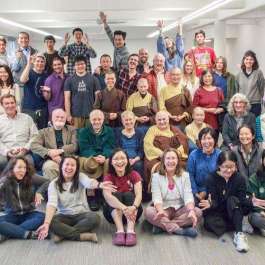
We make up our definitions of happy versus unhappy experiences. And when we do, we draw on cultural norms, our own biases, plus our cravings, aversions, and attachments. Then we mix this together and decide how we are supposed to feel. If you win the lottery, you might find one of these to be acceptable responses: joy, happiness, gratitude, or relief. If you feel unhappy or sad, your friends and family might find your response to be unusual. Sometimes, we create standards that are too regimented. I think about a friend who has decided that right now she must be sad. While that is her overarching theme, there have been plenty of times during her declared time of sadness that I have heard her laugh and express gratitude and appreciation. I think we have had outings where we had fun. Either she is an amazing actress, or she is experiencing more than sadness.
Most of us have a range of emotional experiences that rise and fall throughout the day. If you are in the midst of grieving, perhaps you assume that you feel nothing but sorrow for 24 hours each day. You might feel pressured for this to be true. Pay attention. Many emotions will visit you.
One of my teachers told me that his ability to accept and to embrace the tragedy that has come his way is directly correlated to his ability to allow joy and happiness into his life. What he shared with me was that we need to be open to all of the feelings. We do not get to allow ourselves to only dwell in the positive. We cannot live the Dharma and selectively numb ourselves to the negative. He also observed that in some of the most difficult times in his life he felt sorrow and hope, despair and joy.
Within sadness there is an element of joy. Life is both tragic and beautiful. Most of us will have times in our life when we are in the tragedy of life, while other times we will be in the beauty of life. This same teacher said that this dynamic reminds him of those picture games that can be found online. You look at an image and describe what you see. Some people will see an elderly woman. Others see a beautiful young princess. It is all about how we look at it—both the picture and our lives.
We might be inclined to think that joyfulness is better than sadness. That is a very conventional human perspective: let’s be happy all of the time. Buddhism teaches us to embrace all emotions at the same level, no matter how we perceive that emotion. The concept of causes and conditions reminds us that there will be difficulty and loss. And when there is difficulty and loss, it is appropriate to be sad. When sorrow arises, go with it. Observe it. Please pay attention to what it is like to experience loss. While I was grieving, this recognition of emotions arising was tremendously freeing for me. There were days when I would realize that I was sad. Sometimes it would just pop into my mind: “Oh, today I am feeling sorrow.” It did not mean that it would last all day or that it would be debilitating. Once recognized, the feeling became my companion and not my master. I was able to go about my business. And I set my expectations for myself based on the fact that sadness was going to spend part of the day by my side.
Another of my teachers shared an expression that hit home with me, and I hope that you will find it helpful too: “. . . a steady deep intimacy with our experience without preference.” She finds that while on retreat, her mind slows down, the chatter goes away, and she can make space for something more profound. And that is when some of her deepest and perhaps previously unrecognized emotions come to the surface. The first sign of their arrival is often a feeling in her chest or her belly. She has learned to give those emotions a silent greeting: “Oh hello. Come on up. Join me in my practice of insight.”
In this way, she tended to the grief that she had suppressed over the death of her father. He died when she was very young. When he died, she did not have the coping skills to express her grief. Her elders encouraged her to move on. The grief was there, waiting for her. And later in life, while meditating, she met her grief. She learned to greet it gently. Not to resist it, nor think of it as harmful or inconvenient. To hold it and watch it and feel it, with kindness and compassion. There was nothing to do about it but to just let it be. What a powerful reminder that when something shows up for you in meditation, it is not necessarily a call to action. It is a call to being. A reminder that mindfulness is not just paying attention. It can also be interpreted as being with something. Once you notice your emotion and you greet it and allow it just to be, you might find yourself moving on. “Ok, grief, that’s you. Oh, I am hungry. Now grief is replaced with hunger.” It is all part of the rising and falling.
Today, you and I will be happy and sad and hopeful and annoyed and hungry and so many things. Why don’t we spend time with these feelings? We can greet each one as an honored guest who brings us the gifts of awareness, curiosity, and insight.
See more
Margaret Meloni: Death Dhamma
The Death Dhamma Podcast (Margaret Meloni)














